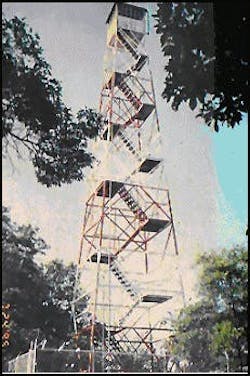Fire Tower Observers' Watch in Lakewood, NJ, is Over
By Steven Rodas
Source nj.com (TNS)
The Lakewood Fire Tower’s watch has ended.
The 136-foot structure, first built by Jersey Central Power and Light Company in 1944 for a sum of $360, was decommissioned in early July and will be fully demolished later this year, first responders and state officials told NJ Advance Media this week.
There are plans to build a new tower in Jackson Township and to use aircraft to survey for wildfires until then. But it’s unclear what will happen with the property, which is now surrounded by a growing residential neighborhood boasting $1.25 million multi-family homes — and a water tower that is blocking some of the fire lookout’s views.
New Jersey Department of Environmental Protection spokeswoman Caryn Shinske said the property on Massachusetts Avenue is owned by NS Holdings, LLC and was leased by the state. Now that the lease is ending, the property owner asked for the tower to be removed. Tax records show the property, a third of an acre in a multi-residential zone, was bought in 2015.
“I don’t know if they own an adjacent property and plan to do a larger development …I don’t know if they know what they’re going to do with it, and if they do (develop something) they can come to one of our land-use board meetings,” said Lakewood Mayor Ray Coles.
Even with modern technology, detecting wildfires in 2024 still relies in part on the eyes and ears of trusty lookouts.
It was observers at the very Lakewood tower that spotted flames in the spring of 2021 during a wildfire that ultimately injured one firefighter and destroyed several properties.
A new tower will be constructed at the New Jersey Forest Service’s Forest Resource Education Center — State Tree Nursery in Jackson, which the state determined “would be an ideal site,” Shinske said.
The state does not yet know how much removal or construction of the new tower will cost.
While a construction timeline is set for the new Jackson fire tower, which is slated to be 129 feet tall, state first responders said aircraft from the Coyle Field Air Attack Base will be deployed “on wildfire detection missions” if smoke is detected in areas near the Cedar Bridge, Lebanon or Jamesburg fire towers.
“Electric service to the tower has been discontinued and the Forest Fire Service is in the process of removing additional items for the tower,” the state spokesperson added Tuesday. “Until the tower is removed from the property, the Forest Fire Service has the ability to staff the tower, if needed.”
In 1974, the Lakewood tower was moved about 300 feet because of “a property dispute” but remained active after that.
The use of fire towers gained popularity in the 1900s, according to nonprofit National Forest Foundation. They still prove crucial today, giving a bird’s eye view of a potential wildfire’s size and location — which can be vital for response efforts.
As many as half of all wildfires reported in New Jersey trace back to tower detection, the state said. The other half comes from the public, nearby aircraft and forest patrols.
“At least one tower in each division is operated whenever the woods are dry enough to burn and all towers are staffed during the months of March, April, May, October and November,” forest service officials describe online with a map of the state’s currently active fire towers.
And detection continues to be important — the largest wildfire reported so far this year happened on July 4 when a firework ignited 4,000 acres of Wharton State Forest.
Last year marked the most active wildfire season in the state in over 20 years.
The state’s Forest Fire Service responded to 1,193 wildfires which burned through more than 18,000 acres across the state. Fourteen of those blazes surpassed 100 acres, thus labeled “major wildfires.”
A local fire station noted online — observing the conclusion of the Lakewood Fire Tower’s time in the Garden State — that the post proved useful for more than fires in its time. During WWII, station officials said, the tower listened to U-boat communications in the Atlantic Ocean some 12 miles to the east.
Fire service officials said the process of using aircraft to look out for forest fires — a measure that will be used while the Lakewood tower is removed — has a storied history in New Jersey too.
“In 1927, State Fire Warden Colonel Leonidas Coyle recognized the utility of using aircraft to assist in the suppression of fire,” said Shinske. “The early aircraft in this program were used for observing and mapping fires and later had the ability to drop water on wildfires.”
Nowadays, the state’s Forest Fire Service deploys a fleet of helicopters and fixed wing aircraft to assist in missions. Aircraft assist in wildfire suppression efforts too.
©2024 Advance Local Media LLC. Visit nj.com. Distributed by Tribune Content Agency, LLC.






